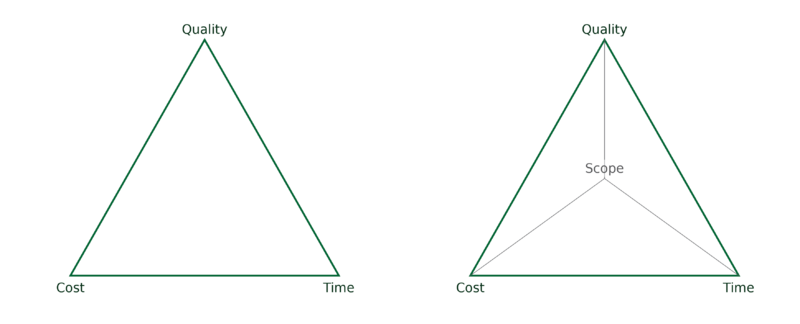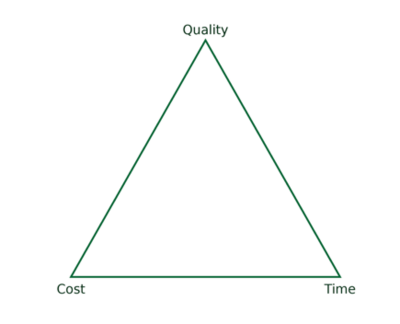Iron triangle
| Line 18: | Line 18: | ||
| − | [[File:TCQx2.png|800px|thumb|center|The Iron Triangle, to the left, with the three ground pillars. To the right | + | [[File:TCQx2.png|800px|thumb|center|The Iron Triangle, to the left, with the three ground pillars. To the right, the Iron Triangle with a fourth pillar]] |
| − | |||
| − | |||
'''Time''' | '''Time''' | ||
| + | The time is the plan, schedule and the deadlines operating as boundaries for the project. All projects must be delivered within a timeframe, and it must be evaluated whether it is realistic to deliver a task in the define time. If the time is being shortening, the quality is decreased, and the cost must raise to reach the proposed scope [4]. The desire about time, is to have the shortest project as possible. The timetable will often be reconsidered many times during a project. Deadlines will be exposed and new will emerge. | ||
| + | |||
| + | '''Cost''' | ||
| + | The cost is the budget and the resources used throughout the project. A project must be reasonable, thus an estimation of budget, needed resources and human hours are executed. Many uncertainties can affect the cost of the project, which often leads to overspending. However, occasions for lowering the cost can likewise appear. Though, if the cost is lowered, the quality is decreased, whilst the time must increase to reach the intended scope [4]. All project managers appeal to execute the cheapest project as possible. The cost can be redefined throughout the project. | ||
'''Quality''' | '''Quality''' | ||
| + | The quality stands for the value of the result at the end of the project. The quality is measured by defined requirements. When aiming for a better quality than the intentional both time and cost must increase [4]. All project managers want to achieve the premier level of quality as possible. However, this must not exceed the requirements from the customer. The overall quality of the project and the final result can first be evaluated when the project is ended. The opinion on the quality can be individual and is not always as easy to measure as the two other constraints in the triangle [5]. | ||
Revision as of 19:03, 21 February 2021
The Iron Triangle for project management, also called The Magic Triangle or The Project Triangle, is a tool illustrating the ground pillars when carrying out a project; time, cost and quality (TCQ). Traditionally, a project has been perceived as a success, when being able to deliver within time, cost and quality. The definition and formulation of the model and its ground pillars change according to sources. In some models, a fourth pillar is included, the Scope [2] [4]. This will be discussed in the article. When aiming for a successful project it would be optimal if there were no restrictions to especially the period and economical aspect, to deliver the highest quality when ending the project. However, all projects operate within constraints set to fulfil the overall given task. The Iron Triangle demonstrates the dependence of the ground pillars, as they are dependent resources with a pin-point approximation of the focus of the project. The triangle is an overall simple model to positioning the project between the three different variables all important to consider when aiming for a good final result. The usage of the Iron Triangle can be defined as the quote express; “The goal of the model is to maintain the focus of the triple constraint power structure on the project higher purpose.” [6]. The model is used in project management to plan and deliver a project.
However, many projects do not success within the constraints set for time, budget and quality. Thus, the limits are often exceeded [1]. All projects are unique and complex and must be managed individually [2]. Thus, the model has limitations as a project’s success cannot be managed by only three boundaries, but the Iron Triangle can be used as guideline concerning project management [3].
This article will present the definition of the three ground pillars, their dependence and the application of the model in project management. As a conclusion on the article, the limitations of the model will be presented.
Contents |
Big idea
The Iron Triangle is a model based on three constraints, time, cost and quality, which create a frame for project management and a path towards a successful result. In project management time and cost are highly dependent and linked directly to handling and planning a project. The quality aspect of the model is more discussed, and over time the third factor has been replaced by Scope, Performance, or Requirements. However, the model often returns to its original form as TCQ. The links between time, cost and quality has been identified as strong and decidedly connected contrary Scope, Performance, or Requirements. The three constraints have been commonly acknowledged as a success criteria and tool in project management. However, a large amount of literature [5] specify that there are many factors affecting the conclusion of success of a project whilst other elements affect the success of the management. This will be discussed further down.
The Iron Triangle is usually illustrated with the three ground pillars at each vertices of the triangle, as illustrated in the figure below. Some editions of the model have positioned Scope in the middle as illustrated in the second figure. The three ground pillars all contribute to the boundaries of the tasks towards the scope.
Time The time is the plan, schedule and the deadlines operating as boundaries for the project. All projects must be delivered within a timeframe, and it must be evaluated whether it is realistic to deliver a task in the define time. If the time is being shortening, the quality is decreased, and the cost must raise to reach the proposed scope [4]. The desire about time, is to have the shortest project as possible. The timetable will often be reconsidered many times during a project. Deadlines will be exposed and new will emerge.
Cost The cost is the budget and the resources used throughout the project. A project must be reasonable, thus an estimation of budget, needed resources and human hours are executed. Many uncertainties can affect the cost of the project, which often leads to overspending. However, occasions for lowering the cost can likewise appear. Though, if the cost is lowered, the quality is decreased, whilst the time must increase to reach the intended scope [4]. All project managers appeal to execute the cheapest project as possible. The cost can be redefined throughout the project.
Quality The quality stands for the value of the result at the end of the project. The quality is measured by defined requirements. When aiming for a better quality than the intentional both time and cost must increase [4]. All project managers want to achieve the premier level of quality as possible. However, this must not exceed the requirements from the customer. The overall quality of the project and the final result can first be evaluated when the project is ended. The opinion on the quality can be individual and is not always as easy to measure as the two other constraints in the triangle [5].
Application
The Iron Triangle is used for project management, when a project has a defined start and end. Project Management is utilising a gathering of models, tools and techniques to move a unique project forward within the variables time, cost and quality [1] .
Limitations
Thus, the Iron Triangle is an incomplete model [1] , as there are many factors affecting and controlling a project. The success of a project cannot be controlled by three factors but must contain aspects of e.g. benefits for the customer and end-user [2].
Annotated bibliography
Maylor, H. (2010): Project management, Chapter 4, 4.2
References
- ↑ 1.0 1.1 Atkinson, R. (1999): Project management: cost, time and quality, two best guesses and a phenomenon, its time to accept other success criteria, International Journal of Project Management, DOI:10.1016/S0263-7863(98)00069-6
- ↑ P.M.I. (2017): A Guide to the Project Management Body of Knowledge, 6th edition, Project Management Institute

